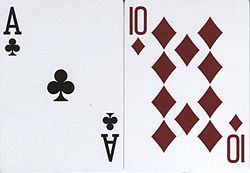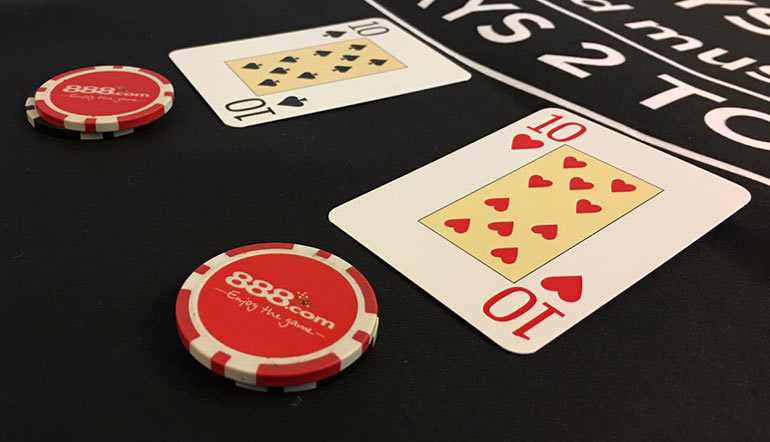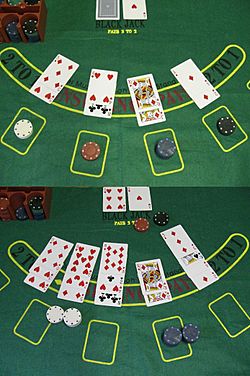Blackjack Split 10 And Jack
Splitting pairs carries a massive potential when it comes to maximizing your profits at the blackjack table. This move can be just as lucrative as doubling down but unfortunately, the vast majority of recreational players find themselves in a quandary when they are dealt a pair.
- Blackjack Split 10 And Jackie Kennedy
- Blackjack Split Aces
- What Numbers Should You Split In Blackjack
- Hands To Split In Blackjack
- Blackjack Split 10 And Jack Nicholson
- When To Split In Blackjack Chart
- Blackjack Split Rules
Blackjack Basic Strategy for Splitting Pairs of Sevens How to Play a Pair of 7's in Blackjack Hard hands: Hard 8 or less - Hard 9 - Hard 10 - Hard 11 - Hard 12 - Hard 13 - 16 - Hard 17 to 21. Split or Hit It is advised to split pairs of 2s, 3s or 7s if the dealer's card is from 2 to 7. In other cases it is advised to hit, as there is a high possibility of the dealer to go bust. Split or Hit It is advised to split a pair of 4s only if the dealer's card is 5 or 6. When playing blackjack against the dealer, most casual players split 10s when he has a weak upcard like a 5 or 6 (although I have seen many players during my career split 10s no matter what the dealer shows). Their logic for splitting on the dealer’s 5 or 6 goes something like this: “The dealer has a weak card and I’ve got a good chance.
Some split all pairs regardless of the two cards’ rank while others prefer not to split altogether. And there is the third group of unskilled players who follow their gut and split pairs at random. What they tend to forget is that blackjack is a purely mathematical game and as such, it does not allow you to make intuitive decisions as is the case in other card games like poker.
- Bonus⋆80 Free Spins
- Bonus$300
- $500$600
The irony lies in that splitting pairs was introduced not only to make the game more exciting but also for the purpose of reducing the house edge. In fact, the house advantage increases by nearly 0.60% if players are altogether prohibited from splitting pairs.
Instead of taking advantage of the splitting option to increase their profits, many blackjack players make awful splitting decisions which only end up making money for the house. The following article aims at clarifying when and why pair splitting is the optimal playing decision and when players should refrain from it.

Pair Splitting – How Does It Work?

The concept of pair splitting is a simple one to grasp – when players are dealt a pair of cards of equal value, like J-10, 4-4, or A-A, they have the option to split and play them as two separate hands.
For instance, suppose your original hand consists of a pair of 7s and you have initially wagered $10 on it. You have the option to play your hand as a 14 and hit or stand depending on the dealer’s upcard but you can also decide to split the 7s into two separate hands. If you choose the latter, you need to post a second bet to the same amount as your original one so that your action increases to $20.
Keep in mind that you cannot announce your decision to split verbally only but must indicate it with a hand signal, which in this case is to form a V shape with your index and middle fingers and tap the felt next to your betting circle.
The chips for the extra bet should never be placed on top of those for the original one. Instead, you position them next to your initial stack of chips. The dealer would then separate the 7s into two hands and draw one extra card on each 7. The two hands are then played one after the other, with players having a choice from the standard playing decisions. Should they receive another pair, they typically have the option to resplit.
Rule Variations Pertaining to Pair Splitting
The tricky thing about pair splitting is that the rules pertaining to this move may vary depending on which casino you are playing at. In most establishments and online blackjack variations, players are allowed to resplit until they form up to four separate hands.
Blackjack Split 10 And Jackie Kennedy
The resplitting of Aces is prohibited at many tables which gives the house edge a boost roughly of 0.08%. Note that split Aces receive only one additional card and players are not allowed to take a hit afterward. This peculiarity of the rules increases the house edge by around 0.19%. There are also casinos that allow you to split ten-value cards but only if they are of the same denomination like a pair of 10s or a pair of Jacks.
In most cases, doubling down after splitting (DAS) is allowed which enables you to increase your action to up to 8 bets (i.e. if you have resplit to four hands and doubled on each one). Another important thing to keep in mind is that when you split a pair of Aces and draw a ten-value card next to your Ace, the hand is not considered a blackjack. It is counted as a regular total of 21 so you receive even money if you win. DAS is a very profitable rule for the blackjack player and its absence (NDAS) is quite detrimental, taking away around 0.14% from your advantage.
How Pair Splitting Helps Blackjack Players
Blackjack Split Aces
As we mentioned briefly in the beginning, pair splitting is very useful because it decreases the house edge by nearly 0.60%. But how does it help the player exactly? If you take a look at the basic strategy chart, you will notice that similarly to doubling down, splitting is mostly recommended when the dealer’s upcard is weak enough to justify an increase in your bets.
This is the right course of action particularly against dealer upcards like 4, 5, 6, and 7 but whether or not this is the optimal move also depends on what pair of cards you are holding. Splitting helps players in several ways.
First, it guarantees they generate more profits on average over the long run because they pour more money on the felt against a weak dealer who is more likely to lose.
Second, splitting enables you to minimize your average losses over the long term which is just as important.
And last but not least, this playing decision gives you the opportunity to turn a bad starting hand into a good one, potentially increasing your chances of winning the round.
Here are several examples of how pair splitting helps you win more, lose less, and transform a bad hand into a good one.
Pair Splitting Allows You to Maximize Your Profits
Our first example involves a hypothetical situation where you get dealt paired 9s against a dealer with a 6 at a multiple-deck table where the dealer is required to stand on soft 17 and you can split to up to four hands. If you choose to stand on your total of 18, you will win 64 out of every 100 hands on average and lose the other 36 times.
The odds are clearly in your favor in this case. When you flat bet with a base unit of $10, you can expect to generate profits of $2.80 per hand on average (640 – 360 = 280 / 100= 2.80) provided that you always choose to stand on your paired 9s against a dealer whose upcard is a 6.
The interesting thing here is that splitting this pair decreases your chances of winning by 4% to 60% but increases the profits you generate. You win only 60 out of every hundred hands on average and lose the other 40 times. Thus, your average profit when you split this pair against the 6 will be equal to (600 – 400) * 2 = 200 * 2 = 400 / 100= $4. This corresponds to a $120 increase in your profits per every hundred split hands with a base unit of $10.
Pair Splitting Helps You Minimize Your Losses
Splitting clearly gives your winnings a good boost but it also helps you reduce your losses from negative expectation bets. For example, when the dealer starts their hand with a deuce and you bet $10 only to get dealt a pair of 7s for a lousy total of hard 14. This hand has over 50% probability of busting.
Let’s see what happens if you decide to consistently stand on your paired 7s with a flat bet of $10. The odds swing in favor of the house this time as your expected win rate drops to 36 out of every hundred hands. Therefore, you lose 64 out of every hundred hands, which corresponds to average expected losses per hand of $2.80. But what if you split your pair of 7s?
Splitting improves your likelihood of success because it allows you to start each of the two hands with a 7 instead of 14. Consistently making this decision will cause you to lose only 55 out of every hundred hands and win the other 45 times. It follows there is a drop in your average net losses per hand of $0.80 because (550 – 450) * 2 = 200 / 100 = 2 and $2.80 – $2 = $0.80.
Splitting Helps You Improve Your Hand Sometimes
One of the most rewarding occasions at the blackjack table is when a player starts a round with a poor two-card total but improves it after a split. Let’s examine a third example where you bet $10 and again receive paired 7s but this time your dealer exposes a 6 instead of a deuce. Many rookie players choose to stand. Yet, this is anything but a good decision and here is why.
What Numbers Should You Split In Blackjack
When you choose to stand with 7s against a weak dealer with a 6, you will win an average of 42 out of every hundred hands and lose the other 58 hands. You are again facing a negative expectation and your long-term losses per hand amount to $1.60.
The option of splitting gives you the chance to start each of the two hands with a 7. This is a significant improvement in the odds since now you are facing a positive expectation in the long run. When you split your 7s against a 6 consistently, you end up winning 52 out of every hundred hands and lose only 48 hands on average. This accounts for net profits of ($520 – $480) * 2 = $40 * 2 = $80 / 100 = $0.80 per hand on average.
Hands To Split In Blackjack
The Pairs You Should Never Split
Some players are governed by their intuition when splitting pairs which ultimately results in losing money over the long run. In blackjack, some pairs should never be split, or at least not if basic strategy is your only weapon in the battle against the casino. Such is the case with pairs of 5s and pairs of ten-value cards.

Blackjack Split 10 And Jack Nicholson
When you start a round with a pair of 10s, you face two possible playing decisions – you either stand on your pat 20 or split the pair. Some inexperienced players tend to choose split, especially against a dealer with a weak upcard like 5 or 6.
They justify this move because they supposedly have the opportunity to win two hands instead of one because the dealer is in a breaking position with these small cards. But they are wrong because this only ends up costing them more money in the long term. Standing on pat 20 wins 78 out of every hundred hands you play on average against a dealer with a6 who hits soft 17.
In 11 of the remaining instances, you tie with the dealer and win in the other 11 cases, which means standing earns you roughly $6.78 per hand (provided that you use a bet unit of $10). If you choose to split your 10s, your average expected win rate per round decreases to around $5.60 for both hands combined. You end up winning less money despite increasing your action when in a favorable position, which is why you should never split 10s unless you are counting cards.
The same applies to pairs of 5s – you should always refrain from splitting those if you use only basic strategy at the table. A starting hand with a total of 10 puts you in a very good position. You risk ruining your hand and losing twice as much in the process.
When To Split In Blackjack Chart
The Pairs You Should Always Split
Basic strategy dictates one should always split pairs of Aces and 8s but many novices choose not to listen. Paired 8s make for the worst possible total in the game and even more so if the dealer exposes a strong ten-value card.
A total of 16 should always be surrendered against a dealer 10 but not so if it consists of two 8s. Inexperienced players often forfeit this pair in exchange for half of their bet out of fear they might end up with two bad hands instead of one and lose twice as much in a single round.
And indeed, there is no room for doubt a pair of 8s against a dealer with a strong ten-value card puts you in a very bad spot regardless of whether you choose to hit, stand, split or surrender. You will inevitably end up losing money. However, playing two hands with a starting point of 8 causes you to incur smaller long-term losses than playing one hand with a total of 16 against a powerful dealer with a 10.
Both hitting or standing in this situation lead to winning only 23 out of every hundred hands while the other 77 hands result in losses, excluding the pushes. If you bet $10 per hand, you will end up losing an average of $540 by hitting or standing.
Splitting actually increases your chances of success with this card holding. If you make this move, you win 38 out of every hundred hands on average and lose the remaining 62 times. Therefore, you incur net losses of ($240 * 2) / 100 = $480 / 100 = $4.80 per hand. There is a slight improvement since you lose $0.60 less per hand when splitting.
Pairs You Should Always Split Additional TipsPlayers who chicken out and surrender their paired 8s against a 10 lose only half of their initial wager. This means they will lose $500 / 100 = $5 on average over the course of every hundred paired 8s they surrender against the dealer’s ten-value card.
Surrendering is obviously costlier than splitting since it causes you to lose $0.20 more per hand. Every now and then, you will end up losing both bets after you split but at least you can have the peace of mind you made the mathematically correct move which ultimately saves you money in the long term.
The same goes for pairs of Aces which basic strategy players are always recommended to split no matter what the dealer’s upcard is. The two Aces result in a soft 12 which is a hand you are going to break frequently. Suppose you are playing a six-deck game and start a fresh round of play with A-A after the dealer has reshuffled.
Blackjack Split Rules
There are 96 ten-value cards in the shoe out of 312 possible cards, which means your chances of catching a 10 next to your Ace are around 1/3 or 30.8%. If you indeed end up pulling 10s next to each Ace, you are practically unbeatable with your total of 21. The worst that can happen is pushing with the dealer.
Why would then someone hesitate to split Aces is beyond us. The Aces are powerful cards in blackjack, which is why casinos typically enforce various restrictions on splitting them in order to decrease the advantage this move gives the players. They prohibit hitting after splitting Aces and the resplitting of Aces.
Remember the house is well-familiar with the mathematics of the game so do yourself a favor and always stick to basic strategy when playing pairs, or at least until you master card counting and playing deviations.
US Players and Credit Card, BitCoin Deposits Accepted!
How to Play a Pair of 7's in Blackjack
Soft hands:Soft 13 - 14 - Soft 15 - 16 - Soft 17 - Soft 18 - Soft 19 to 21
Splitting pairs:Aces - 2's - 3's - 4's - 5's - 6's - 7's - 8's - 9's - 10's
Should You Split Seven's?
A pair of sevens should be split if the dealer is showing a 2 through 7.
If the dealer has an 8 or better, take a hit.
Reasoning
Assuming the dealer has a 10 in the hole, and she's showing a 2 through 7, then the dealer might have a total of 12 through 17. All of those hands except the 17 are stiff hands and are likely to bust.

If you split the 7's and assume you catch a ten, you'll have a total of 17. Not only will that beat all those totals except the 17, the dealer has a good chance of busting.
On the other hand, if the dealer has an 18 or better, you're pretty much going to lose most of the time, so there is no point in putting more money in the house's pocket. Just take the hit and hope you get lucky.
